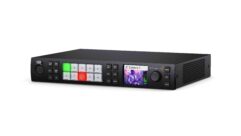
Inside the HDBaseT 2.0 Specification, Part 1
Oct 8, 2013 10:56 AM,
With Bennett Liles

Listen to the Podcasts
|
Editor’s note: For your convenience, this transcription of the podcast includes timestamps. If you are listening to the podcast and reading its accompanying transcription, you can use the timestamps to jump to any part of the audio podcast by simply dragging the slider on the podcast to the time indicated in the transcription.

It escaped from the lab and now it can’t be stopped. HDBaseT, one of the biggest developments in pro AV now goes to the next level with HDBaseT 2. Chipset manufacturer Valens is at the forefront of HDBaseT and Dana Zelitzki is here from Valens to give us the latest on the new HDBaseT 2 specification. That’s coming up next on the SVC Podcast.
Dana, thanks for joining us on the SVC Podcast from Israel and Valens, the originating company and driving force behind HDBaseT. And we’re leading off with HDBaseT 2, the new spec that’s in all the AV news lately. Tell us a little about HDBaseT 2.0. What’s it all about and why all the hoopla about it right now?
Dana Zelitzki: Thanks. I’m happy to be here with you also. First of all, we’re excited about HDBaseT 2.0 as well. It is the latest specification released by HDBaseT Alliance and it’s the result of long development work by all HDBaseT Alliance members, so it’s really joint development of both leading professional AV companies and leading consumer electronics companies. And this is exactly what the purpose of the new spec is, actually to bring the HDBaseT user experience that the professional AV are already familiar with and are already accustomed to, to the mainstream consumers’ homes.
So this mainly impacts the residential AV market?
Well it does, of course, add improvements to the professional AV also in terms of performance and implementation. It will make the implementation of the equipment much simpler, and adds many features to it. But I think the big news, and this is why everyone is so excited about HDBaseT 2.0, is that we are really bringing HDBaseT to the consumers. [Timestamp: 2:21]
And with HDBaseT initially we heard a lot about 5Play and now we’re hearing about HomePlay. Is that a different feature set?
Well, yes. Of course we’re not neglecting the 5Play feature set. 5Play is the essence of HDBaseT, but we’re adding some features to it. From a technical perspective, we’re adding features such as networking capabilities, control point capabilities, switching capabilities. These will all enable true HDBaseT switching, unlike the first specification that really was focused on the physical link. Also the first specification was point-to-point connectivity standard. The second specification adds multi-point connectivity and multi-stream support. [Timestamp: 3:11]
I would think that the really big thing about this is the ability to go point to multi-point with HDBaseT now because this should bring in a whole range of new applications.
Exactly. So we’re actually enabling sending the entire 5Play feature set from any source to any display, including switching and multiple streams from multiple types. In addition, we’re adding integrated supports for USB 2.0 as well as other native interfaces. It is true that it was also available, in some way, in HDBase1.0, but now this is an inherent part of the chip set so that will make an HDBaseT switch smaller, less expensive, and simpler to implement. [Timestamp: 3:58]
How will the HDBaseT switches work? What sorts of specific applications are you going to be able to implement with these?
Let’s talk about the classic use case, or classic application, of an HDBaseT switch inside a home. Basically the HDBaseT switch is designed to provide all required services for a multimedia home, and let me describe the use case. Let’s say you have an HDBaseT switch in a home and it’s connected to all the sources that you have in the house; to your Blu-ray player, to your PC, your laptop, to your gaming platform, to anything—basically anything. And instead of having multiple devices in every room in your house, you can have all these devices connected to the HDBaseT switch tucked away in the basement or some communication cabinet. And from this switch, you’re connected by HDBaseT with a single Cat-5 cable to all the displays around the house. And with a simple control application that can be installed on your smart phone or tablet, you can select from any room in the house what source you’d like to use. Let’s say I’d like to watch a movie from my Blu-ray player. I can select it, I can control it since we’re sending the controls as well, I can pause it, go to the bedroom, continue to watch it from my bedroom and basically do whatever I want. [Timestamp: 5:25]
Inside the HDBaseT 2.0 Specification, Part 1
Oct 8, 2013 10:56 AM,
With Bennett Liles
Okay now in applications with the 2.0 spec, is this going to require shielded cable or are you still able to go with regular unshielded Cat-5, Cat-5/e, Cat-6 or whatever?
Cat-5/e and just like the first version. Another use case—I think this is one of the reasons USB 2.0 is so important—is if I take my flatscreen display in my bedroom, for example, again that’s connected to a switch and the switch is also connected to my PC—again somewhere downstairs or in the basement—I can select the PC as a source and with a single click, my TV or my flatscreen display on my wall turns into my PC. And since we’re sending USB as well, so with a wireless keyboard and mouse I can, of course, control it and work on it just like a regular PC. [Timestamp: 6:18]
Now with the 2.0 spec is there going to be any impact on the power-carrying capability of HDBaseT? Is that still going to be 100W to the full 320ft.?
No impact on the power capability. We’re still at 100W over 100 meters. [Timestamp: 6:32]
So now that you’ve had the 2.0 spec announcement and the initial wave of news about that, what’s the next step toward implementation?
The improvement and release of HDBaseT 2.0 specification is a very important milestone, which really leads the way to the development and release of HDBaseT 2.0 chips followed by HDBaseT 2.0 products. [Timestamp: 6:53]
So the manufacturers get onboard just like they did before and that seems to be a fairly rapid process.
Well they’re already involved. It was a joint work by all Alliance members, so manufacturers are really, most of them at least, are already involved. It’s not the first time that they’ve heard about it. [Timestamp: 7:11]
I was talking about power just a minute ago and we’ve had a lot of discussion generated about HDBaseT and the power spec and how much you can actually send over the line and to what distance. How much actual line loss are we talking about with PoH on say, a hundred meter run with Cat-5 or Cat-5e? Is there a significant power loss?
No, we don’t think it’s significant. We may encounter up to 10 percent line loss, which is pretty common, but really it’s still sufficient to power many TV models in the market. And I think that’s the reason everyone talks about the power of our HDBaseT feature because it’s such an amazing one. [Timestamp: 7:48]
And an especially handy feature for digital signage applications and using LCD displays.
There are already TV models with the power feature implemented, so they’re actually a single-wire TV, which is a great product. [Timestamp: 8:04]
Yeah, there have been a lot of those demonstrated at infoComm and it’s sort of strange seeing nothing but one twisted-pair cable going into the display. You have to sort of get used to that.
Yes. At industry shows and events we’ll be participating, people just stop at our booth, even if they didn’t hear about HDBaseT. They take pictures of the single-wire TV; they call their friends. They’re not used to seeing that, but they will get used to it. [Timestamp: 8:28]
Yeah, they were initially ducking about and trying to find the secret power cable somewhere.
Exactly.
And it’s a little strange but I still see articles online about HDBaseT being the so-called HDMI killer and replacing it, but that’s not really the case is it? It’s really a technology to be the missing link for HDMI to be able to carry it a useful distance in addition to the 5Play features.
Yes. We don’t see HDBaseT as a replacement of HDMI. We actually see it as a complimentary technology to HDMI. I mean HDMI is great for connecting your Blu-ray or anything else to your TV, of course when it’s in close proximity. Also, of course, you can find HDMI today in almost every TV and almost every device, so it’s there and it’s important. However, HDMI, as you said, just cannot go the distance that some use cases require. So I guess when you need more than a simple point-to-point closed connection or when you need greater distances, or like in HDBaseT 2.0 when you want to connect all your devices throughout the home, HDBaseT is the option for you. [Timestamp: 9:41]
Filling in the distance problem with HDMI and adding the 5Play features have really put HDBaseT on the map over past couple of years. Dana thanks so much for joining us for part one and in part two we’ll get into some more details on HDBaseT and the new 2.0 spec and what you can do with it. It’s been nice having you here.
Great. Thank you.










